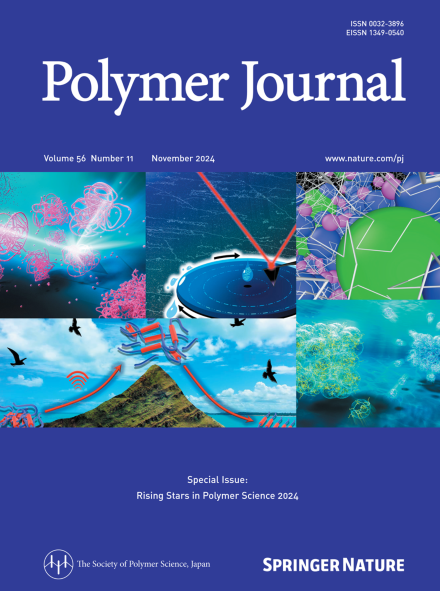抗溶菌酶Fab抗体调节配体依赖性可逆聚集的增压设计
IF 2.7
4区 化学
Q3 POLYMER SCIENCE
引用次数: 0
摘要
蛋白质聚集和液-液相分离(LLPS)作为关键的物理化学过程,协调了蛋白质的行为和功能,而设计蛋白质表面电荷为调节蛋白质-蛋白质相互作用以及聚集和相分离提供了一种强大的方法。在蛋白质表面工程方法中,通过用带电荷的氨基酸残基取代表面残基导致蛋白质净电荷的急剧增加。以前的研究报道了蛋白质的一些物理化学性质通过增压得到改善,并且改变表面电荷被认为会影响分子间的相互作用。在这项研究中,我们设计了一个新的增压抗原结合片段(Fab)抗体突变体,并研究了它的聚集行为。通过对所设计的增压抗体的物理化学性质的检验,尽管抗体和抗原具有相同的电荷对,但抗体的热稳定性、结构和配体结合亲和力仍然保持不变。此外,我们发现抗体表现出可逆的配体和盐浓度依赖性聚集。我们的研究证明了增压如何潜在地调节蛋白质聚集和LLPS。期望该方法可以推广到其他蛋白质,从而探索其在各种生物和生物技术领域的适用性。蛋白质聚集和液-液相分离(LLPS)协调蛋白质的行为和功能。工程蛋白表面电荷为调节这些现象提供了一种强有力的方法,而增压,用带电的残基取代表面残基,导致蛋白质净电荷的剧烈变化。在这项研究中,我们设计了一个新的增压抗原结合片段抗体突变体,并研究了它的聚集行为。我们发现该抗体在保持物理化学性质的同时表现出可逆的配体和盐浓度依赖性聚集。我们的研究证明了增压如何潜在地调节蛋白质聚集和LLPS。本文章由计算机程序翻译,如有差异,请以英文原文为准。

Supercharging design of an anti-lysozyme Fab antibody to regulate ligand-dependent reversible aggregation
Protein aggregation and liquid‒liquid phase separation (LLPS), as key physicochemical processes, orchestrate protein behavior and function, and engineering a protein surface charge offers a robust approach to modulate protein‒protein interactions and, consequently, aggregation and phase separation. Among protein surface engineering methods, supercharging leads to a drastic increase in the protein net charge by replacing surface residues with charged amino acid residues. Previous studies have reported that some physicochemical properties of proteins are improved by supercharging, and changing the surface charge is considered to affect intermolecular interactions. In this study, we designed a new supercharged antigen-binding fragment (Fab) antibody mutant and investigated its aggregation behavior. Upon examination of the physicochemical properties of the designed supercharged antibody, the thermal stability, structure, and ligand binding affinity of the antibody were retained despite having the same charge pairing of both the antibody and the antigen. Furthermore, we revealed that the antibody exhibited reversible ligand- and salt concentration-dependent aggregation. Our study demonstrated how supercharging can potentially modulate protein aggregation and LLPS. It is expected that this approach can be extended to other proteins, through which its applicability in various biological and biotechnological fields can be explored. Protein aggregation and liquid‒liquid phase separation (LLPS) orchestrate protein behavior and function. Engineering protein surface charge offers a robust approach to modulating these phenomena, and supercharging, which replaces surface residues with charged ones, leads to a drastic change in the protein net charge. In this study, we designed a new supercharged antigen-binding fragment antibody mutant and investigated its aggregation behavior. We revealed that the antibody exhibited reversible ligand- and salt concentration-dependent aggregation while retaining the physicochemical properties. Our study demonstrated how supercharging can potentially modulate protein aggregation and LLPS.
求助全文
通过发布文献求助,成功后即可免费获取论文全文。
去求助
来源期刊

Polymer Journal
化学-高分子科学
CiteScore
5.60
自引率
7.10%
发文量
131
审稿时长
2.5 months
期刊介绍:
Polymer Journal promotes research from all aspects of polymer science from anywhere in the world and aims to provide an integrated platform for scientific communication that assists the advancement of polymer science and related fields. The journal publishes Original Articles, Notes, Short Communications and Reviews.
Subject areas and topics of particular interest within the journal''s scope include, but are not limited to, those listed below:
Polymer synthesis and reactions
Polymer structures
Physical properties of polymers
Polymer surface and interfaces
Functional polymers
Supramolecular polymers
Self-assembled materials
Biopolymers and bio-related polymer materials
Polymer engineering.
 求助内容:
求助内容: 应助结果提醒方式:
应助结果提醒方式:


